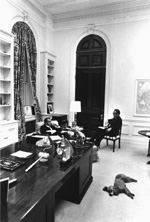
President Richard Nixon (left behind desk), his poodle Vicky, and Secretary of State Henry Kissinger in room 180 in November 1971. White House Photo.
However, Room 180 is rich with White House history. Much of the public would be unfamiliar with how past Presidents have used this room as an escape, as a place to work and even for scandal. Here is where many of Nixon's tapes from the "Watergate Scandal" were recorded in the early 1970's and where Vice-Presidents Humphrey and Bush have also had an office.
From the West Wing, it is a short walk across West Executive Avenue and up the stairs of the EEOB Building to Room 180. A few Presidents have been known to have an additional office in the EEOB, as an escape from the West Wing. Today, Vice-President Cheney holds two offices: one in the West Wing and another on the second floor of the EEOB referred to as "The Vice-President's Ceremonial Office."
After President Kennedy was assassinated in 1963, Vice President Johnson was sworn in as President and could rightfully occupy the Oval Office. However, out of respect to the late President Kennedy, President Johnson retained his Vice Presidential office upstairs in Room 274 as his day-to-day working office. The Oval Office was only used as his "public" or ceremonial office. As LBJ's Vice President, Hubert Humphrey used Room 180 since 274 was unavailable.
When Nixon came into office in 1969, he redecorated Room 180 as his second office. He also chose to use the Oval Office as his ceremonial office while Room 180 became his working office, where he would meet with staff and Administration officials.
The desk that now is located in the VP's Ceremonial Office was made in 1902 for Theodore Roosevelt and Nixon chose to use it for his day-to-day office in Room 180. It is believed that Nixon had a hole drilled into the desk to hide his phone cords and a lock was placed on the left hand drawer to secure the tape recorder contained within, which documented some of the infamous "Watergate" phone conversations. Both the hole and the lock still remain today.